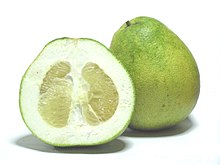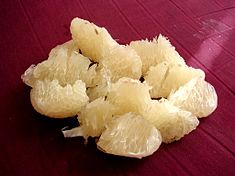Citrus grandis
| Pomelo | |
|---|---|
 |
|
| Scientific classification | |
| Kingdom: | Plantae |
| (unranked): | Angiosperms |
| (unranked): | Eudicots |
| (unranked): | Rosids |
| Order: | Sapindales |
| Family: | Rutaceae |
| Genus: | Citrus |
| Species: | C. maxima |
| Binomial name | |
|
Citrus maxima Merr. |
|

Flesh of a pomelo
|
|
| Nutritional value per 100 g (3.5 oz) | |
|---|---|
| Energy | 159 kJ (38 kcal) |
|
9.62 g
|
|
| Dietary fiber | 1 g |
|
0.04 g
|
|
|
0.76 g
|
|
| Vitamins | |
| Thiamine (B1) |
(3%)
0.034 mg |
| Riboflavin (B2) |
(2%)
0.027 mg |
| Niacin (B3) |
(1%)
0.22 mg |
| Vitamin B6 |
(3%)
0.036 mg |
| Vitamin C |
(73%)
61 mg |
| Minerals | |
| Iron |
(1%)
0.11 mg |
| Magnesium |
(2%)
6 mg |
| Manganese |
(1%)
0.017 mg |
| Phosphorus |
(2%)
17 mg |
| Potassium |
(5%)
216 mg |
| Sodium |
(0%)
1 mg |
| Zinc |
(1%)
0.08 mg |
|
|
|
|
|
| Percentages are roughly approximated using US recommendations for adults. Source: USDA Nutrient Database |
|
Citrus maxima (or Citrus grandis), (Common names: pomelo, pomello, pummelo, pommelo, pamplemousse, jabong (Hawaii), shaddick, or shaddock) is a natural (non-hybrid) citrus fruit, with the appearance of a big grapefruit, native to South and Southeast Asia.
Citrus maxima was originally called "shaddick" in English, after the captain of an East India Company ship who introduced it to Jamaica in 1696. The word "pomelo" has become the more common name, although "pomelo" has historically been used for grapefruit. (The 1973 printing of the American Heritage Dictionary, for example, gives grapefruit as the only meaning of "pomelo".)
The etymology of the word "pomelo" is complex. In the Tamil language it is called "pampa limāsu", which means big citrus. The name was adopted by the Portuguese as "pomposos limões" and then by the Dutch as "pompelmoes". The name can be found with some deviations in many European languages, for example German (Pampelmuse), Latvian (Pampelmūze), Ido (Pompelmuso), whereas some other languages use "pomelo" (Turkish, Norwegian, Polish).
This fruit is often called by "shedock" by English authors from the name of a British captain, however another theory proposed that "pomelo" is an alteration of a compound of English names pome ("apple") + melon.
Citrus maxima is native to Southeast Asia where it is known under a wide variety of names. In large parts of South East Asia, it is a popular dessert, often eaten raw sprinkled with, or dipped in, a salt mixture. It is also eaten in salads and drinks. It is called in Maithili- टाभ नेबो(taabh nebo) that makes special अर्घ(argh-an offering plate with distinct farm fruit ,tubers and roots) in छठ पूजा (Chhathh Pooja - a two days fast observed and end with worshipping the setting Sun and rising Sun God).
...
Wikipedia
